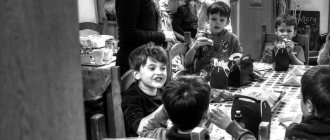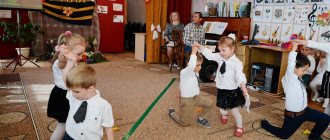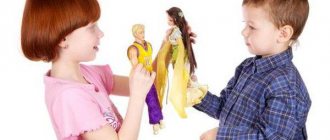Club program "Folk Games"
MUNICIPAL BUDGETARY PRESCHOOL EDUCATIONAL INSTITUTION
"KINDERGARTEN "SEVERYANOCHKA" OF A GENERAL DEVELOPMENTAL TYPE WITH PRIORITY
IMPLEMENTING THE PHYSICAL DEVELOPMENT OF CHILDREN"
ACCEPTED: APPROVED:
At the pedagogical council, Head of MBDOU D/S "Severyanochka"
Protocol No._________________________________________________С. V. Zaitseva
CLUB PROGRAM
for children 4 – 7 years old
Implementation period 3 years
Compiled by:
Smychagina O. M. FC instructor of the highest qualification category
MBDOU "SEVERYANOCHKA"
With. Gorki
2014 – 2015 academic year G.
Introduction
Human personality is a harmony of thought and movement. Currently, the formation of a physically healthy, active, harmoniously developed person is of great importance. Particular attention should be paid to outdoor games, since play evokes a great emotional response in children and helps them engage in academic work more painlessly. Games contribute to the proper physical development of the body. Children learn various outdoor games and daily activities with them.
This program is relevant because it participates in solving one of the most urgent tasks of modern education - the formation of a healthy lifestyle for preschool children through specially organized physical activity of the child.
Explanatory note
Everyone knows that children love to play. This desire must be skillfully used in the interests of the children themselves, developing and nurturing in them such necessary qualities as strength and dexterity.
Folk games are part of the patriotic, aesthetic and physical education of children. They develop a stable, interested, respectful attitude towards the culture of their native country, creating an emotionally positive basis for the development of patriotic feelings: love for the Motherland; its culture and heritage. In terms of content, all folk games are classically laconic, expressive and accessible to children.
Game as a means of education
.
The development of outdoor games for educational purposes is associated with people’s lifestyle. The games reflect the characteristics of the mental makeup of nationalities, ideology, education, level of culture and scientific achievements. In addition, some games take on a certain color depending on geographical and climatic conditions.
The health value of outdoor games.
Properly organized outdoor games should have a beneficial effect on the growth, development and strengthening of the musculoskeletal system and muscular system. To develop correct posture in children and adolescents. Outdoor games that involve various large and small muscles of the body in varied, mainly dynamic, work become of great importance.
"Sticks"
Let's start with a game called "Sticks". Have you heard of this one? I learned about it from my grandmother. She said that when she was little, life was difficult for them; there was not always food in the house, let alone toys. That's why they played with sticks in the street. This fun also has another name - “Crippled”.
You can play in the yard with a large group. It's always more fun to play with a big group! You will need sticks to play. Typical sticks are about 30 - 40 centimeters long and can be easily found in the surrounding area. All players except the leader should have such sticks.
At the leader’s signal, the children place the chopsticks on their palm or finger; they place them, not put them down. And they try to hold the stick in this standing position without holding it with the other hand. The stick, naturally, does not want to stand and tends to fall. In order to hold it, it is necessary to move not only your hand, but also move your legs.
The presenter can “add fuel to the fire” and invite the players to squat or stand on one leg, everything is at his discretion. The one who holds the stick longer than the others wins. And the loser is the one who drops the stick first. He becomes the new presenter.
"Burners"
Another ancient beautiful and interesting game. The game has one leader and many players. Players become pairs and line up behind each other. Or rather, pair after pair. The leader stands with his back to them at a distance of two steps from the first couple.
The last pair of players unclenches their hands, runs around the column of players on both sides and tries to stand first. But the presenter interferes with them; his task is to tarnish one person from the couple. If he succeeds, then he stands first in the column along with the greasy player. And the player left without a pair becomes the leader. If the players manage to grab hands before the leader greases them, then they become the first, and the game continues.
The host cannot spy on the players. He should stand with his back to them and look forward. But, as they say, it is better to see once than to hear a hundred times.
"Towns"
First, a small lyrical digression. About 8 years ago, when my husband was actively involved in organizing various holidays, and I was helping him, we organized a corporate party on the occasion of the anniversary of a small company. The holiday was themed, on the theme of sports. That is, the host of the party was also the head coach, and everyone present at the celebration were, like, athletes.
We then arranged many different sports locations, fortunately the location allowed, since we held the entire event outdoors. And one of the locations was dedicated to the game of gorodki. She was the most popular. Adults frolicked like children with these bats and tried to hit the wooden cylinders arranged in various shapes. And when it worked out, the joy knew no bounds!
If adults were so carried away, then how should school-age children react to this game?
And if it’s difficult to get ruffles these days, then I think there won’t be any problems with sets for towns.
I am sure that you are familiar with the rules of the game in small towns. Therefore, I’ll just remind you what shapes can be made from small wooden sticks, which, by the way, are called towns.
Traditional Russian fun
On holidays, among Russian folk games, entertainment with a large number of participants was popular, when they could divide into groups and compete with each other. From time immemorial, games with a competitive element have been loved by children of different ages, as they provide an opportunity to test their strength, luck, and dexterity. Such traditional Russian games include “Burners”, “Pull the String”, “Chains” and similar ones.
Game "Drag the String"
In the game “Pull the String,” two hoops are placed on the sides of the court. A rope is stretched along the ground so that its ends are in the middle of each hoop. Preschool children are divided into two groups. The participants of each of them, in turn, stand in their hoop, then, at a signal from the driver (an adult or an older child): “One, two, three, run!”, they change hoops, trying to reach the opponent’s place as quickly as possible and pull the rope. The one who completes the actions faster and without errors becomes the winner. Following the first pair, the second runs, then the third, and so on until the end.
The team whose members were faster and pulled the rope more often wins. An adult must participate in this competition to ensure that the rules are followed.
Game "Burners"
In the classic game "Burners", players stand in pairs in a column. Raised hands form a “gate” through which all couples pass. In front of everyone, with his back to the other players, stands the driver, who is also called the “burning one.” The players say the nursery rhyme in chorus: “Burn, burn clearly, So that it doesn’t go out! Look at the sky, Birds are flying, Bells are ringing. Ding-dong, ding-dong, quickly run out! " At the last words, the children in the pair in front scatter in different directions, the rest shout in unison: “One, two, don’t be a crow, but run like fire!” “The driver turns around and catches up with the fleeing children.
If the players manage to take each other’s hands, and the “burning” one is left with nothing, then they again stand behind the column. The driver again catches or “burns” another pair: the game is repeated.
If it is possible to catch one of the fleeing players, then a new pair is formed. The player who is left without a pair becomes the driver.
Game "Chains"
In Chains, players also form two teams. With a little counting table, for example: “A cuckoo walked past the net, And behind it were little children. The cuckoos are asked to drink. Come out - you'll drive! ", select the "breaker" who will break the "chain". The teams are located opposite each other, the participants hold hands tightly. The driver scatters, runs towards the “chain” of opponents, trying to destroy it.
If successful, he takes the opponent to his group; if it doesn’t work out, he himself remains with the opponents. The team with the most players is the winner.
Quite a lot of similar entertainment has been collected and stored in the national treasury. Most of them are relevant and loved today, for example:
- "Geese-geese";
- "Hide and Seek";
- "Cossacks-robbers";
- "Salki";
- "Blind Man's Bluff";
- "Ring".
Others - “Pleten”, “Ringer”, “Lapta” and others are half-forgotten, have more complex rules that need to be memorized with the children first. Every parent can prepare exciting games, fun, and entertainment for children's parties. It all depends on the interest and desire of the adults themselves.
Russian folk rhymes
The squirrels were treated to hares and carrots were served. We ate all the nuts ourselves. And they told you to drive! - Stork-stork, stork-bird, What do you dream about at night? I want the swamp edges, - And also? More frogs. You can't catch them, you can't catch them. That's it, you drive! We're going to play. Well, who should start? One, two, three - You start driving! The gnome was looking for gold and lost his cap! He sat down and cried: “What can I do?!” Come out! You should drive!
The one who pronounces the counting rhyme, with each word, and sometimes syllable, touches the players in turn with his hand, not excluding himself. Who gets the last word? He becomes the driver.
If there are many participants in the game. Then we think differently: the children say a counting rhyme, and whoever gets the last word leaves the circle, and the counting rhyme is repeated until only one player remains.
An apple is rolling down a steep mountain. Whoever raises it, leave! A suitcase was floating on the sea, There was a sofa in the suitcase, An elephant was riding on the sofa. If you don't believe it, get out!
Often in games, all participants are divided into 2 teams, and you need to decide which of them will start the game. In this case, two players, one from each team, measure themselves against a stick (“contest”). To do this, we took a stick 40-50 cm long, one of the players takes it by the end, the other, pressing his hand tightly to the hand of his peer, grabs it higher, then the first moves his hand higher than the hand of the second, etc. Whichever player grabs the end of the stick wins the right to start the game on his team.
There is an easier way to select the order - guessing in which hand the object is located? Whoever guesses right gets to start first.
To divide the children into teams equally so that no one would be offended, we used agreements. The players are divided into pairs, step aside and conspire among themselves. It is necessary to negotiate quietly so that the presenters do not hear. Then the children go to the presenters and ask who they choose, often in the form of a rhyme, for example:
Who do you choose: A black horse or a golden collar? Should I roll the balls or drink the water? What will you take: a ruff from a river or a hedgehog from a forest? A gray duck or a wooden pipe? Who will you invite to visit: a mustachioed cockroach or a striped tiger cub?
Collusions are not difficult to form; as they worked, the children began to come up with them themselves. To prevent children from arguing before the game about who should drive or who should start the game, we used lots. The lot can be any stick (paper), which the drawer hides behind his back and says the words: “Whoever draws the lot, let him lead!”
"Ryuhi"
Before I explain to you the rules of this ancient game, I’ll tell you what ryukha is. Ryuha is a piece of wood. In order to make a ripple, you need to cut a thin log into pieces 20 centimeters long. The larger the ripple, the more interesting it is.
Also, for the game you will need at least two sticks with a diameter of approximately 5 cm and a length of approximately 1 meter.
Everyone who wants to play is divided into two teams. Each team draws a square measuring 1.5 x 1.5 meters on sand or asphalt. And in these squares, each team builds its own city. He makes various figures from ryukh. It is important that the squares are located on the same side, this is for safety.
The horse line is also drawn. This is the line behind which the teams will be located, and because of which they will throw long sticks trying to destroy the enemy’s city and knock all the creatures out of the drawn squares. This is an eco-game. All equipment is environmentally friendly! Yes, and children spend time outdoors.
Again the question arises: “Where can I get ryukhi?” Residents of rural areas have a chance to acquire them; they are lucky. What should city kids do? Well, of course, replace the game of “ryukhi” with the game of “towns”.
"Lapti"
Another game that is perfect for schoolchildren.
On the playground, a large circle is drawn with chalk on the asphalt or with a stick in the sand. The leader stands in the circle. And all other players are located outside the circle.
The players turn their backs to the leader, take off one bast shoe at a time and, at a signal, over their heads, without looking, throw the bast shoes into the circle.
Then they turn around, look where their bast shoe fell, and try to pick up this bast shoe. The leader interferes with them. Trying to dirty, tarnish the players. There could be more presenters, it would be even more interesting. Leaders can only salvage players when they are within the circle.
Those who manage to rescue their shoes from the vicious circle “with impunity” win. Well, the one who gets greased first becomes the leader.
The main question: “Where can I get bast shoes?” Answer: “There’s nowhere to get bast shoes!” But the lack of bast shoes among modern schoolchildren is not a reason not to play. You can replace the bast shoes with something. You don’t even have to take off your sandals and sneakers. It is not recommended to use stones instead of bast shoes. Because you can injure the presenter.
I was thinking that the equipment for this game could be made from an old sock that has long since lost its pair. Stuff the sock with some scraps of fabric or padding polyester and tie. And here’s a wonderful substitute for lap shoes!






